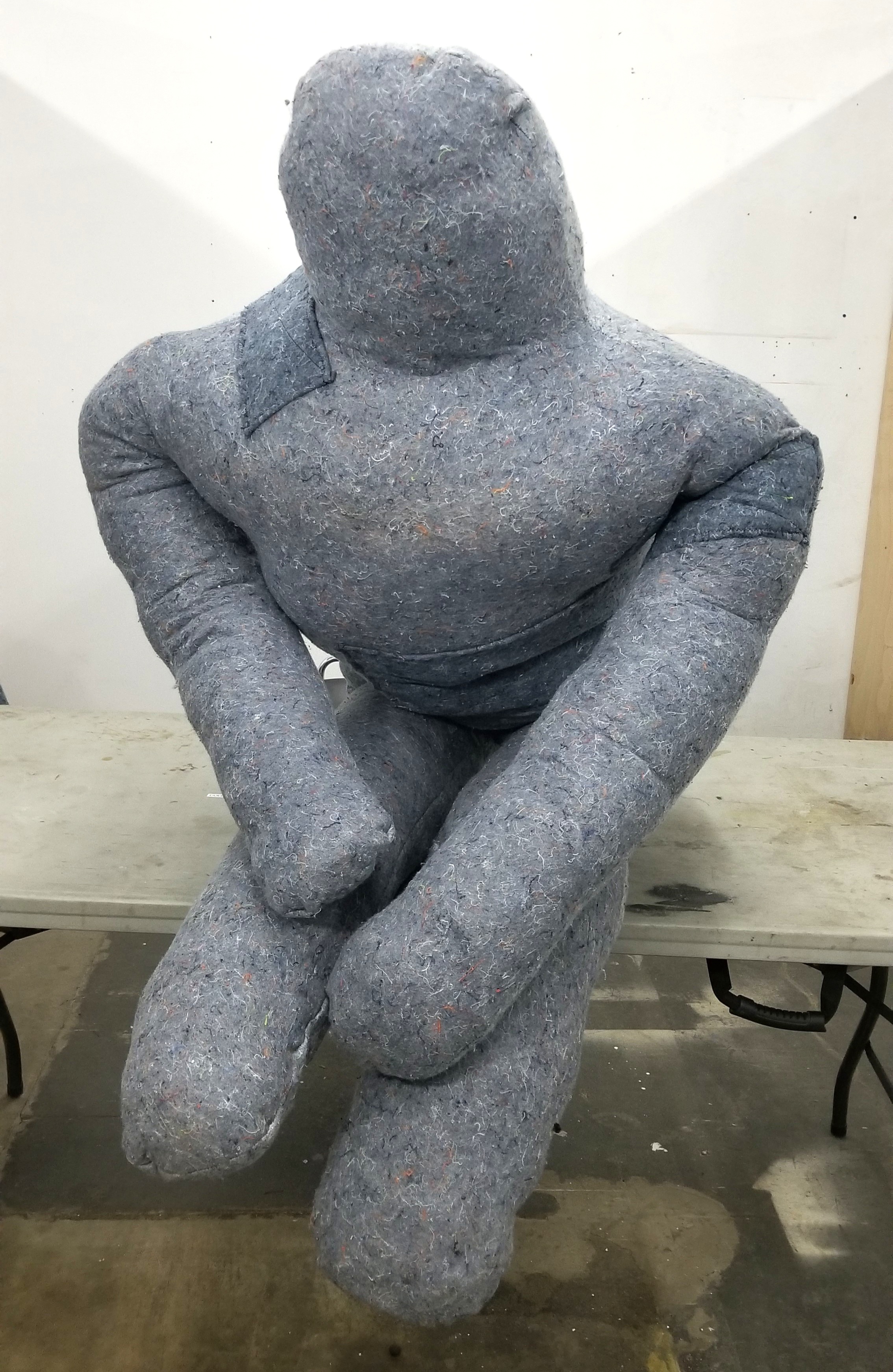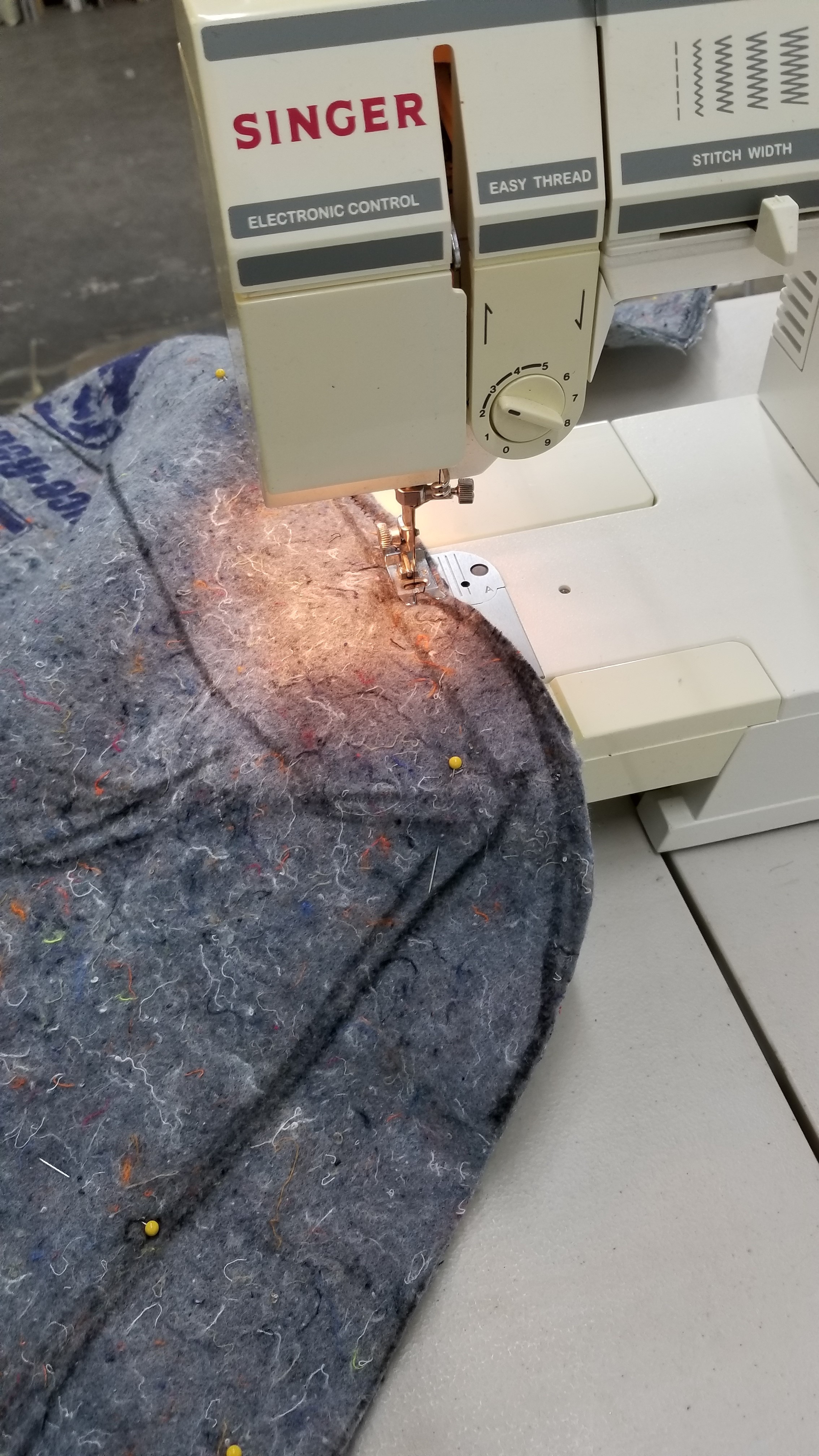Making Lumpy, my studio assistant
6ft tall, ~50lbs.
big boi.
This past weekend I was feeling a bit stir crazy, and decided to sit down and knock out making a few things that didn’t have a months long timeline for completion. One of those assemblages ended up becoming a 6ft tall stuffed dude.
Why?
‘Cause.
Recorded at the Artisans Asylum, at the new Photo Studio
The process started with a few felted moving blankets I had on hand, of which which I really enjoy the visual textures of and all the individual recycled fibers that go into them. They’re about 3/8” thick at the densest areas, and are relatively good at resisting wear (or so I thought).
I ended up throwing them on the floor and cutting them out after tracing out the oversized profile that I’d stick together.
Really just an over complicated stick figure.
What I learned (1): What used to be my sewing scissors are no longer gonna cut it after being used on paper.
And with that I pinned together the two layers that formed the front and back and cut out the profile. I ended up spacing the pins about every 7 inches point to point to save time, and this ended up being sufficient for how much area I needed to cover.
From there, it was just a method of sewing the two halves together.
This old singer desperately needs oiling, but ended up working wonderfully for the time being.
What I’ve learned (2): Keep a stock of threaded bobbins prewound before you ever sink a needle into thread. I think I had to stop six or seven times just to refill the one bobbin I was using, and re-threading the machine each time.
Anyways, I probably wasn’t using the correct settings for the machine, but did remember to double-back on the high tension areas (armpits, crotch, shoulders, neck) to make sure it wouldn’t tear apart instantly. This is also the largest project that I’ve run through this Singer machine, and as I was having to ball up the pieces as I prepped to feed in the next stitch area, it made for some interesting positioning. Which lead to...
What I’ve learned (3): Small folding tables are make for awful outfeed tables. You can see in the time lapse just how many times I reposition to work around not having an area supported.
This was taken after I’d turned the stitched outline inside out and added in the scraps from the outlining to fill out the hands/feet/head
And with that it wrapped up day 1.
Day 2 started with a run to the local sewing store and 20 lbs of polyester batting later. And then the stuffing.
I had my hands full of fluff so I didn’t get many good photos of this but I’d left an opening just under his right armpit to fill in the stuffing. What worked well about that was that I was able to put in a lot of stuffing relatively quickly. The part that didn’t work so well was…
What I’ve learned (4): Test your fabric before you undertake a large project with it. I’d used this recycled felt because it was what I had on hand, but had no idea how it would hold up to stitching or the wear of having high-tension flex points for the joints, which as it turns out ended up being not so great.
The felting of the moving blankets was pretty weak, with the fibers not tightly locked together. I imagine this would be a positive for moving blankets, but not so good for an doll. At the inside armpit edge of the opening for the stuffing the fabric began to thin out and tear as the tension of the stuffing(1) began to mount and the repeated action of waving my arm around in his chest cavity occured.
By the time the chest was full the fabric around the armpit had given out. Rather than taking out the stuffing and turning it back inside out to re-do the seam, I decided to patch it.
You can see the second of three blowouts on the interior of the arm.
Having learned my lesson about the lack of strength in the felting, I seamed the edges of the patch and added a stitched x across the body of the patch to help the patch from coming apart itself.
Also aesthetics, but who cares about that?
All told there were 4 blowouts, all where the blanket was under a lot tension or where the presser-foot adjustment arm of the Singer ate through the fabric when I wasn’t paying attention (oops).
Damn it.
All told I’m not sure that he’d hold together well if move around a lot, so it may be a prescribed sedentary lifestyle for Lumpy, luckily I don’t think he’s needing to get anywhere too quickly.
So far the plan is to suspend him from the rafters above my space at the Artisan’s Asylum, but we’ll see how that goes over with facilities.
Overall though this was a fun project, and the process of making him refreshed quite a few techniques that I’d learned from making fleece pillows with my mom as a kid. Lumpy is essentially a pillow, just with a different profile and much worse fabric.
Anyways, fun to make and good to learn off of. A successful weekend project.
Cheers,
Mac






